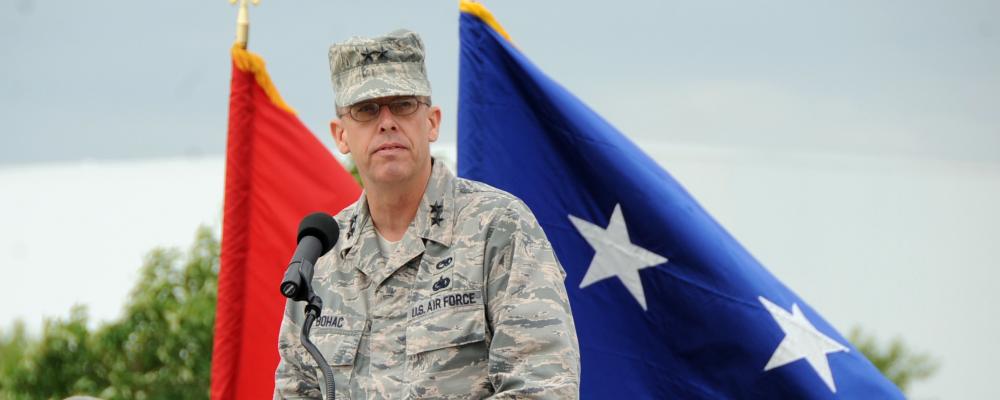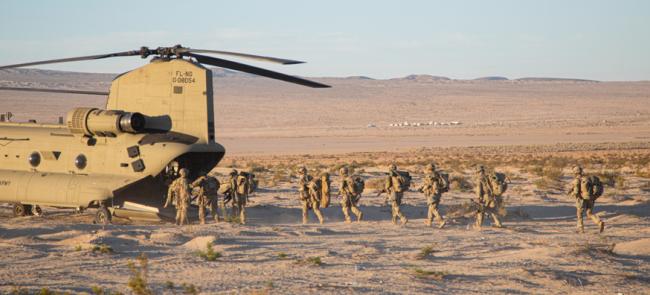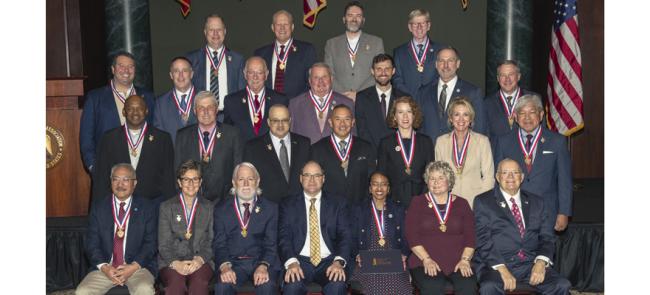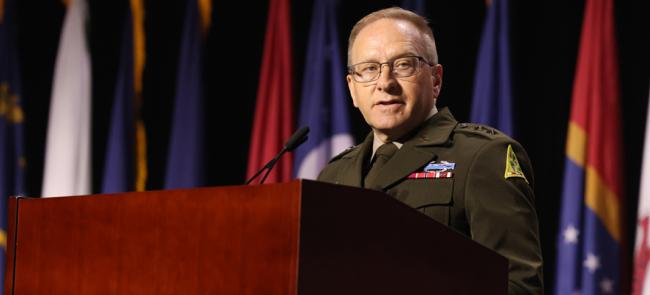
A Conversation with Maj. Gen. Daryl Bohac
Maj. Gen. Daryl Bohac of Nebraska presides over of an association whose numbers belie its stature.
The 54 members of the Adjutants General Association of the United States are collectively responsible for the training and readiness of nearly half of the Army’s combat power and more than a third of the Air Force’s aerial refueling, strategic lift and fighter capabilities. Then there is their role of providing the first military responders in the homeland during disasters.
Those multiple responsibilities give AGAUS clout in many quarters of the Pentagon and on Capitol Hill. National Guard sat down with Bohac, the association’s newly elected president, to discuss AGAUS and the group’s perspectives on some of the issues that confront the entire force today.
The adjutants general have a conduit to the highest levels of the Pentagon in the chief of the National Guard Bureau. Your bosses also have a channel of communication to the Pentagon in the Council of Governors. And you have NGAUS to work Capitol Hill. Why is it still important for the adjutants general to have their own separate voice in defense decision-making?
I think it really starts with the statutory requirement for the chief of the National Guard Bureau to be the conduit of communications to the states and to the governors and the adjutants general. And so we have to be part of that communication linkage and have the ability to communicate with candor back to the Guard Bureau and to the other entities.
I think the other part of this, too, that plays out is that you do have NGAUS and the Council of Governors, but they may have other agendas that the adjutants general may or may not be completely aligned with. But there is always a significant degree of overlap. So having that independent voice of sorts from the adjutants general serves the enterprise well.
It could be said that AGAUS has as many agendas as members. How do you and the group forge consensus when the priority for each adjutant general is the distinct needs of his or her own state or territory?
It really starts with a recognition by the body of 54 that each adjutant general has the responsibility to their governor, to their state to advocate for their unique needs and positions and that’s respected. But the body does a good job, I think, of coming together on key issues to represent the enterprise of the adjutants general. And that’s why we rarely send out letters with all 54 signatures because we understand the power of that. That should be wisely used and judiciously used as a mechanism to convey our point. It’s less about tension, but recognizing the difference between the individual state and the collective good of the several states, territories and the District of Columbia.
AGAUS typically has a few priorities. What are your collective priorities at this time?
We do have priorities. One is the Space National Guard. That’s something that we’re actively working now on behalf of the states and making sure there is a clear articulation by the adjutants general that we think it’s important for there to be a Space National Guard just as there is an Air National Guard and Army National Guard. Also that it’s understood that there is no movement to try to create a Space National Guard in every state. We currently have eight states and Guam that are involved in that mission set and we understand that.
But we think it’s important that we are involved in the mission as we are today. The challenge with that one is the Senate [fiscal 2022] National Defense Authorization Act mark-up talks about simply renaming the Air National Guard to the Air and Space National Guard. That doesn’t really solve anything. That doesn’t solve the issue of having two components being responsible for the same mission set and the lacking of requirements and coordination between Space Force and Air National Guard. So it doesn’t align missions. It doesn’t align command authorities. And we see that as problematic.
The second one really emerged out of the Senate markup of the NDAA as well. It’s the language that talks about no further fielding of the F-35A to the Air National Guard until a 4:1 ratio is achieved by all fielding going to the active component. That has raised significant concerns across the enterprise not just about the F-35 but about any future fielding weapon systems. We’ve worked hard, the adjutants general and the Air National Guard directorate, and have had conversations with the United States Air Force to recognize that there is value to the American people and to our security interests by the balanced, proportional and concurrent fielding of weapon systems in to the National Guard. I think the language also seemingly dismisses the value that National Guard forces convey to the American taxpayer when it comes to a wide use of taxpayer dollars and resources. In general, the cost of an active component unit of similar composition can be about three times more expensive than it is in the National Guard.
A third priority is full-time manning in the Army National Guard. We recognize that the argument that’s been used in the past is that it promotes readiness, which full-time manning does, but we’ve been able to produce the readiness required by the Army of units going forward by their call-ups to meet the combatant commanders’ requirements. That’s not the argument we need to take. We need to focus on the current cost to our force in terms of quality of life. What does it mean when someone is spending all their time on that and how does that impact their family life? So we have some work to do in developing that there. I’d say those are the three things we’re really focused on.
We’re still interested in cyber teams’ development, cyber mission teams across the 54, having that as a capability, there’s more work to be done there. Finally, we are continuing to pay attention to Duty Status Reform and being engaged in that with OSD, and they’ve been great partners on this. We’ll continue to move that forward and get that into the FY23 NDAA so we can begin that process.
The Pentagon has been working on draft Duty Status Reform legislation for nearly a decade. Why has it taken so long?
I think because the initial draft of legislation wasn’t fully vetted through the Guard Bureau and the states. Once our folks were able to get a look at it, we found some issues with Insurrection Act language and other authorities language that were going to be problematic.
One of them, for example, not recognizing units, but talking about individual members of the reserve components. When we look across the reserve components, when we take the Air Force, for example, their Individual Mobilization Augmentee Program, they do manage individuals. But we don’t typically do that in the Air National Guard or Army National Guard. We manage and lead units.
Once we got that relationship built that’s very collaborative, we could move things along. As it moved forward through the process, there were questions by the White House Office of Management and Budget that had to be interpreted before it could move forward for legislative action.
Do you expect Congress as they entertain other issues for fiscal 2023 defense deliberations to complete work?
Our expectations are that by ‘23 it will be introduced through the NDAA, then be recognized to be built into the language. There is a 10-year implementation because of all the other legislation action that will have to follow — rules and policies — so it’s going to take some time. I think there is a belief it can move faster than 10 years, but the important point is to do this right as it goes forward.
What is the benefit for individual Guard soldiers and airmen with Duty Status Reform?
I think the biggest benefit is the alignment of benefits against authorities and to ensure equality across the components that if an airman or soldier goes forward into some kind of contingency response, they are earning the same type of benefits and entitlements as the active component soldier or airman doing the same exact mission at the same location.
AGAUS does not have a continuing presence in the nation’s capital. You also have no full-time staff resources. How do you convey your concerns and priorities to decision-makers in Washington?
Great question. You’re right. We don’t have an office with a staff in Washington, D.C., but what we have is, across the 54, actively engaged adjutants general and their teams that have built relationships with our congressional delegations and convey our concerns. Not only our individual state concerns, but enterprise concerns and discussions. It really falls there. There are some states that have legislative or government relations offices in Washington D.C. Not all states and territories do. But it’s really the relationships over time developed by the adjutants general and their staffs with the congressional delegations that enable us to be effective.
Some at NGB have called 2020 the year of the National Guard. The number of Guardsmen called for domestic missions shattered records. Some of those missions continue to this day. What has the American public learned about the Guard over the last 19 months or so?
I do think 2020 was the Year of the Guard. I think what the American public learned and, I think, has intuitively known and now knows explicitly is that their National Guard forces are one, the military responder of first choice in the homeland, and two, we are an extremely talented force that brings the combination of the civilian experience with the military training that makes us incredibly valuable.
But what we have to do is avoid becoming the Easy Button. What I mean by that is, there has to be some judicious analysis of whether a particular mission is an appropriate mission set for the Guard. Now, the governor, if he or she has funding, can call us in, but there is both the federal and state level of analysis of what looks right. And then respecting the relationship that the preponderance of our force has with their civilian employers, families and communities that they serve and recognizing that that has to be respected in order for us to be successful in the future.
Many in Washington believe the president will request a smaller defense budget next year, for fiscal 2023. The Army and the Air Force certainly will not give up their modernization priorities. Leaders in both services are already talking about making “tough decisions.” Do you think Guard units and equipment will be targeted to pay for modernization? What can be done to protect Guard units and equipment?
I think it’s reasonable to believe that units and equipment will be looked at to offset the cost of modernization and continue to build up the military forces that are responsive to the perceived and real threats to our nation. So we have to be part of that conversation. It’s not that the adjutants general are opposed to change, but I think some of us were around in 2005 and ’06 with the BRAC [Base Realignment and Closure] and then 2012 and 2013 with the budget disagreements with both the Air Force and the Army. We don’t want to have those things happen again.
What the adjutants general have been clear about is, include us up front in the discussions, help us understand where you’re trying to go and if there are going to equipment and/or mission changes, what’s the roadmap to change? What we can never go back to is what we experienced coming out of the 2005/06 BRAC scenario where, particularly in the Air National Guard, we had units uncovered with no missions and they sat idle for months until a plan was developed. That’s not healthy for the Guard, that’s not healthy for the Total Force and that’s not healthy for the nation preserving capability.
Also, I go back to recognizing that if we’re considering the reduction of units and personnel authorizations, look to the National Guard to retain force, to retain equipment because we can do it, on average, much cheaper than the active component. And therefore, those capabilities, those people that have been developed and we want to retain their talent in the system are available when the time comes when their nation needs them or when we can return to more increased budgets for the Department of Defense. And if that’s done, then I think we will protect our units and protect our role as the primary combat reserve in the United States Army and the United States Air Force.
How important is it for the National Guard to retain federal missions across the full spectrum of combat operations?
I think it's really important because going back to my last point — we are the primary combat reserve of the Air Force and Army. And if we want to talk about interoperability and ability to serve together, side by side, in combat operations, then we have to be involved in those discussions from the get-go. That doesn’t mean you’re involved in every mission set, but it means you’re involved in mission sets that involve combat operations so that you can go forward together.
We cannot afford in our nation, I believe, to not be in that posture because it takes too much time to build that kind of readiness. And we saw that, particularly in the Army National Guard, immediately following 9/11. The Army did not have confidence in the readiness of the Army National Guard, so we spent the last 20 years building that readiness. It’s not the time to set that aside and be ill prepared to go shoulder to shoulder when this nation needs us.
Gen. Michael X. Garrett, the Army Forces Command commander, recently asked whether the Army is asking too much of the Guard. What’s your take on the question?
I think it’s a fair question to ask. We should always be looking at that. Are we over reliant on the Guard or the reserve component at large? It’s not simply the Army asking too much. Again, we look at all we’ve been doing in ’20 and ’21. It’s a fair question. Is that a sustainable model? Should we be looking more deliberately at the kinds of missions the National Guard is involved in? If it’s in the homeland, does it have a military nexus or not? Does it enhance readiness or does it distract from readiness? So I think that’s part of the analysis of why the FORSCOM commander, I believe, raised that question.
If we are not asking it, then we are running the risk over overcommitting, which often leads to lower retention rates in our forces, in our units. That’s not a risk we want to assume. I think the validation of the question was a straight-forward one. Are we [asking too much]? I don’t think he answered the question, but rather asked the question so we can do the analysis to understand where we are at.
The National Guard Empowerment legislation of 2011 certainly raised the profile of the NGB chief and the rest of the Guard Bureau.
What impact has Guard Empowerment so far had on the Guard in the 54 states and territories?
I think the biggest impact is not readily seen. I think it’s the discussion and the requirement for the chief of the National Guard Bureau to be the voice of the non-federalized Guard, meaning the day-to-day operations of the National Guard, the impacts, what is their availability to do things, particularly in the homeland. And having that direct voice to the White House is significant. That’s not always well understood because that happens often behind the scenes.
But having that voice there matters. It matters representing our interests not only to the White House, but also with others and to make sure they understand. I think we’ve seen that evolution of understanding and better appreciation among the Joint Chiefs of Staff having the chief of the National Guard being a sitting member, a statutory member of the Joint Chiefs of Staff. That’s in our interest to have that.
The balance question here though is not having the chief of the National Guard Bureau staff being so consumed with that role that they are not paying attention — and I’m not saying they are — to their requirements and being a conduit of information. I think General [Joseph L.] Lengyel [former chief of the National Guard Bureau] started it and General [Daniel R.] Hokanson [current chief of the National Guard Bureau] has continued it in a more frequently engaged method of staying connected with the adjutants general and that has paid dividends. But that’s the balance you are always paying attention to.
The 54 doesn’t always see eye to eye with NGB. The NGB chief, the director of the Army Guard and the director of the Air Guard today are all former adjutants general. It’s the first time this has occurred in several decades. Does it help?
I think it does. I think having [Lieutenant] General [Jon A.] Jensen [the Army Guard director], [Lieutenant] General [Michael A.] Loh [the Air Guard director], and General Hokanson all having served as adjutants general of their states helps bring a perspective to the staff of the National Guard Bureau, whether it’s the Army, Air or Joint staff. It helps them be more connected and to think about the consequences of decisions or implementing guidance on the states, territories and the District of Columbia. I think that has helped in the relationship and helped the staff think more deliberately about that. And I hear all three of those leaders talking about that consistently: We are here to serve the 54. That’s our role, that’s our responsibility. We have to be mindful how our decisions may impact or influence the states, territories and the District of Columbia.
The military is now under a COVID-19 vaccine mandate. How much of a challenge is this for the adjutants general to implement?
We are currently in that mandate. And I’ll say that any kind of mandate or directive is always influenced by how well we communicate policy, guidance and direction. That can always be the challenge, getting it down to the last person in the formation to make sure they understand. Here are the choices, here are the options and here are the consequences of each of those choices. It’s a communication challenge, if anything. It’s certainly a little bit different because of the ideological amplification of concerns and other issues associated with the vaccine.
But, at the end of the day, it’s about retaining soldiers and airmen in the formation and to ensure they are medically ready to go do what our nation and states need us to do. Are we a medically ready force or not ready to do those things? That’s really the concern. But it’s also, I think, recognizing that it’s probably for the first time, in recent history, anyway, we have an issue where the choice of the things like religious accommodation or medical exemption is more public. So it’s making sure our processes are there to support the airman or soldier who wants to seek those exemptions or accommodations and that the process serves us well. I think that if we do all that well, then we’ll be fine.



